#barred spiral galaxy NGC 5068
Text

The James Webb Space Telescope imaged bright tendrils of gas and stars belonging to the barred spiral galaxy NGC 5068, whose bright central bar is visible in the upper left of this image. (Image credit: ESA/Webb, NASA & CSA, J. Lee and the PHANGS-JWST Team) - https://www.space.com/james-webb-space-telescope-behind-bars-star-formation
#barred spiral galaxy NGC 5068#NGC 5068#galaxy#universe#astronomy#love#godscreation#god's creation#james webb telescope
6 notes
·
View notes
Text

Infrared Bar
61 notes
·
View notes
Photo
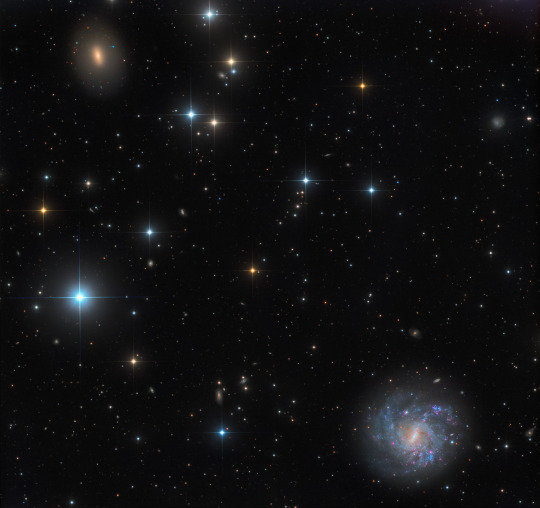
NGC 5068 (lower right) and NGC 5087 (upper left) // Brian Valente
#astronomy#astrophotography#galaxy#spiral galaxy#barred spiral galaxy#elliptical galaxy#star-forming galaxy#NGC 5068#NGC 5087#virgo
60 notes
·
View notes
Text
Discovery Alert! Zoom into NGC 5068. In a new discovery released on June 02, 2023 James Webb Telescope Reveals the Hidden Beauty of NGC 5068's Star Formation.
This video takes the viewers on a journey to the barred spiral galaxy NGC 5068, whose bright central bar is visible in the upper left of this image. NGC 5068 lies around 17 million light-years from Earth in the constellation Virgo. Read full article here
#james webb space telescope#nasa#jwst#webb telescope#webb discoveries#exoplanets#james webb discoveries#NGC 5068
123 notes
·
View notes
Text
Hey babes, new space just dropped.

A delicate tracery of dust and bright star clusters threads across this image from the NASA/ESA/CSA James Webb Space Telescope. The bright tendrils of gas and stars belong to the barred spiral galaxy NGC 5068, whose bright central bar is visible in the upper left of this image. NGC 5068 lies around 17 million light-years from Earth in the constellation Virgo.
youtube
23 notes
·
View notes
Photo
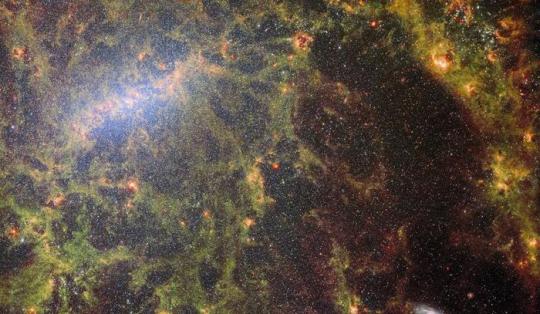
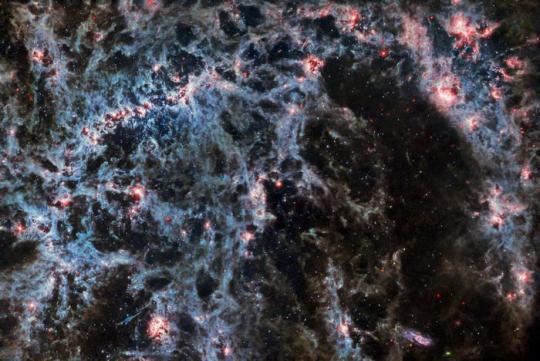

NASA’s Webb Space Telescope peers behind bars A delicate tracery of dust and bright star clusters threads across this image from the James Webb Space Telescope. The bright tendrils of gas and stars belong to the barred spiral galaxy NGC 5068, whose bright central bar is visible in the upper left of this image – a composite from two of Webb’s instruments. NASA Administrator Bill Nelson revealed the image Friday during an event with students at the Copernicus Science Centre in Warsaw, Poland. NGC 5068 lies around 20 million light-years from Earth in the constellation Virgo. This image of the central, bright star-forming regions of the galaxy is part of a campaign to create an astronomical treasure trove, a repository of observations of star formation in nearby galaxies. These observations are particularly valuable to astronomers for two reasons. The first is because star formation underpins so many fields in astronomy, from the physics of the tenuous plasma that lies between stars to the evolution of entire galaxies. By observing the formation of stars in nearby galaxies, astronomers hope to kick-start major scientific advances with some of the first available data from Webb. The second reason is that Webb’s observations build on other studies using telescopes including the Hubble Space Telescope and ground-based observatories. Webb collected images of 19 nearby star-forming galaxies which astronomers could then combine with Hubble images of 10,000 star clusters, spectroscopic mapping of 20,000 star-forming emission nebulae from the Very Large Telescope (VLT), and observations of 12,000 dark, dense molecular clouds identified by the Atacama Large Millimeter/submillimeter Array (ALMA). These observations span the electromagnetic spectrum and give astronomers an unprecedented opportunity to piece together the minutiae of star formation. With its ability to peer through the gas and dust enshrouding newborn stars, Webb is particularly well-suited to explore the processes governing star formation. Stars and planetary systems are born amongst swirling clouds of gas and dust that are opaque to visible-light observatories like Hubble or the VLT. The keen vision at infrared wavelengths of two of Webb’s instruments — MIRI (Mid-Infrared Instrument) and NIRCam (Near-Infrared Camera) — allowed astronomers to see right through the gargantuan clouds of dust in NGC 5068 and capture the processes of star formation as they happened. This image combines the capabilities of these two instruments, providing a truly unique look at the composition of NGC 5068. The James Webb Space Telescope is the world's premier space science observatory. Webb will solve mysteries in our solar system, look beyond to distant worlds around other stars, and probe the mysterious structures and origins of our universe and our place in it. Webb is an international program led by NASA with its partners, ESA (European Space Agency) and the Canadian Space Agency. TOP IMAGE....This image of the barred spiral galaxy NGC 5068 is a composite from two of the James Webb Space Telescope’s instruments, MIRI and NIRCam. Credits: ESA/Webb, NASA & CSA, J. Lee and the PHANGS-JWST Team CENTRE IMAGE....In this image of the barred spiral galaxy NGC 5068, from the James Webb Space Telescope’s MIRI instrument, the dusty structure of the spiral galaxy and glowing bubbles of gas containing newly-formed star clusters are particularly prominent. Three asteroid trails intrude into this image, represented as tiny blue-green-red dots. Asteroids appear in astronomical images such as these because they are much closer to the telescope than the distant target. As Webb captures several images of the astronomical object, the asteroid moves, so it shows up in a slightly different place in each frame. They are a little more noticeable in images such as this one from MIRI, because many stars are not as bright in mid-infrared wavelengths as they are in near-infrared or visible light, so asteroids are easier to see next to the stars. One trail lies just below the galaxy’s bar, and two more in the bottom-left corner. Credits: ESA/Webb, NASA & CSA, J. Lee and the PHANGS-JWST Team LOWER IMAGE....This view of the barred spiral galaxy NGC 5068, from the James Webb Space Telescope’s NIRCam instrument, is studded by the galaxy’s massive population of stars, most dense along its bright central bar, along with burning red clouds of gas illuminated by young stars within. This near-infrared image of the galaxy is filled by the enormous gathering of older stars which make up the core of NGC 5068. The keen vision of NIRCam allows astronomers to peer through the galaxy’s gas and dust to closely examine its stars. Dense and bright clouds of dust lie along the path of the spiral arms: These are H II regions, collections of hydrogen gas where new stars are forming. The young, energetic stars ionize the hydrogen around them, creating this glow represented in red. Credits: ESA/Webb, NASA & CSA, J. Lee and the PHANGS-JWST Team
4 notes
·
View notes
Text
Hubbles Multi-Wavelength View of Recently-Released Webb Image
Hubble is sharing a brand new galaxy image every day through October 7, 2023! Visit our website daily, or follow along on X, Facebook, and Instagram. Patches of bright pink and wisps of dark red paint the foreground of this new NASA Hubble Space Telescope image. NGC 5068 is a barred spiral galaxy with thousands […]
from NASA https://ift.tt/ubnd1I5
0 notes
Text
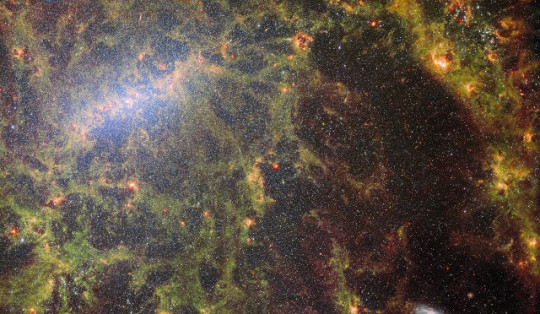
An image captured by the James Webb Space Telescope shows the core and part of a spiral arm of the galaxy NGC 5068. Two instruments, MIRI and NIRCam, were used to examine this barred spiral galaxy, and the various infrared filters allowed to detect an enormous amount of detail among dusty structures and star-forming areas where there are newborn stars still surrounded by shells of gas and dust.
About 20 million light-years from Earth, the galaxy NGC 5068 belongs to the most common class in the universe, spiral galaxies. The presence of a star formation extending from the core in a shape resembling a bar places it in the subclass of the barred spiral galaxies, which probably make up about two-thirds of their class.
1 note
·
View note
Text
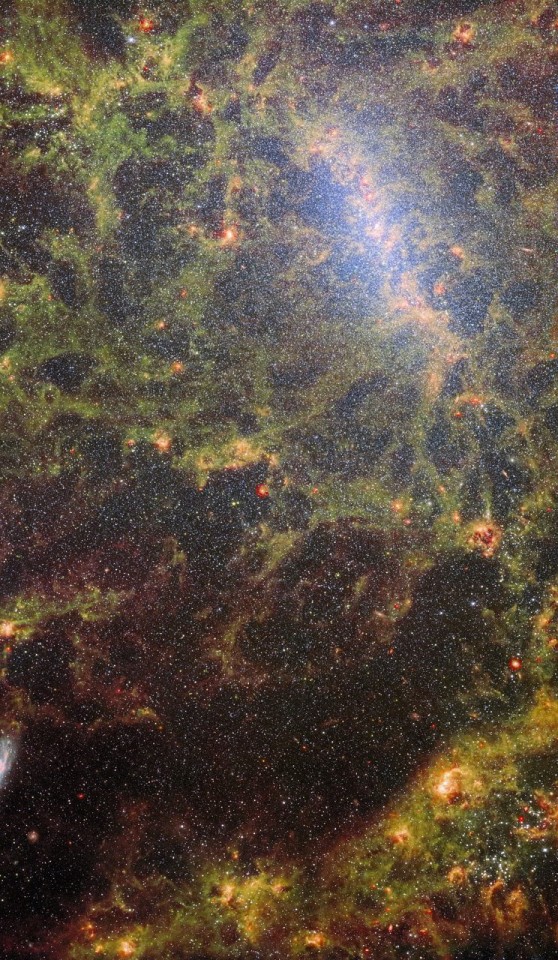
Barred Spiral Close-Up
59 notes
·
View notes
Text
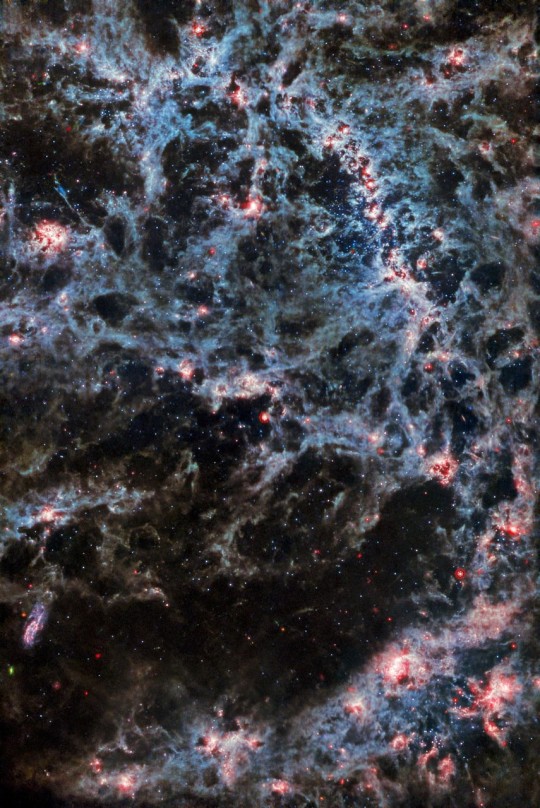
Barred Galaxy's Insides
82 notes
·
View notes
Text
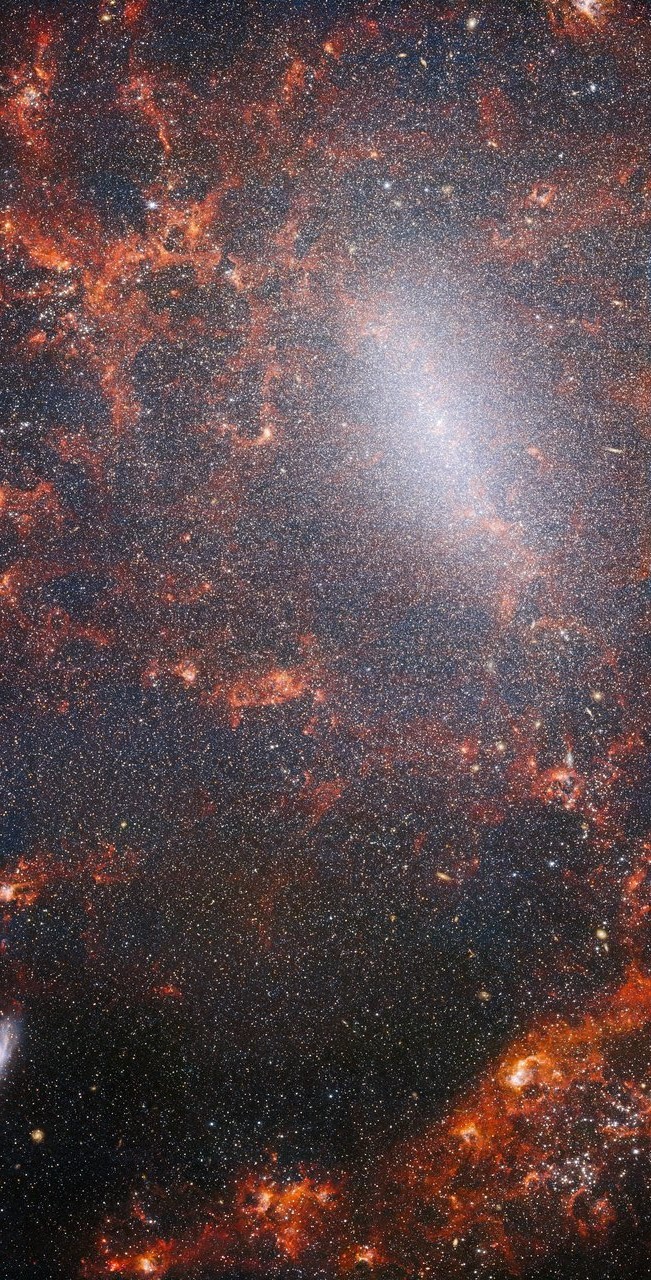
Near-Infrared Bar
49 notes
·
View notes
Text
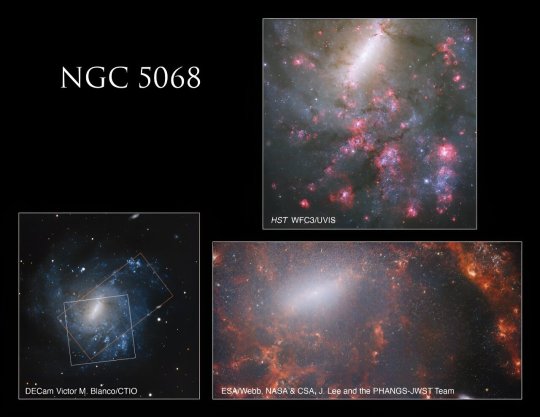
Hubble's multi-wavelength view of recently released Webb image
Patches of bright pink and wisps of dark red paint the foreground of this new NASA Hubble Space Telescope image. NGC 5068 is a barred spiral galaxy with thousands of star-forming regions and large quantities of interstellar dust. First discovered by British astronomer William Herschel in 1785, NGC 5068 sits in the southern region of the constellation Virgo and is around 20 million light-years away. Astronomers estimate the galaxy is 45,000 light-years in diameter.
At the top center of this image lies NGC 5068's bright central bar, a densely packed region of mature stars. A black hole lurks behind the bar, tugging the stars together with its intense gravitational pull. The bright pinkish-red splotches along the bottom and sides of the image are regions of ionized hydrogen gas where young star clusters lie. Though not very clear from this angle, these splotches are along the galaxy's spiral arms, where new stars typically form.
Astronomers also found at least 110 Wolf-Rayet stars in NGC 5068. Wolf-Rayet stars are a type of old, massive star that loses mass at a very high rate. They are typically more than 25 times the mass of our sun and up to a million times more luminous. There are about 220 Wolf-Rayet stars in our Milky Way galaxy.
NGC 5068 is difficult to see with human eyes because it has relatively low surface brightness. Luckily, Hubble's ultraviolet, visible, and near-infrared capabilities helped capture the beauty and intrigue of this galaxy. Different cosmic objects emit different wavelengths of light; young and hot stars emit ultraviolet light, so Hubble uses ultraviolet observations to find them.
In June of 2023, NASA's James Webb Space Telescope released its own infrared image of NGC 5068 as part of a science campaign to learn more about star formation in gaseous regions of nearby galaxies. Many of Webb's observations are building on earlier Hubble observations, specifically a collection of 10,000 images of star clusters.
IMAGE....This NASA Hubble Space Telescope image (upper-right) includes ultraviolet, visible, and near-infrared light. The Webb image (lower-right) is in infrared. The lower-left, wide-field image of NGC 5068 places the locations of the Hubble and Webb images within the context of the entire galaxy and to each other. Credit: NASA, ESA, R. Chandar (University of Toledo), and J. Lee (STScI); Processing: Gladys Kober (NASA/Catholic University of America), DECam, Victor M. Blanco/CTIO, CSA, J. Lee and the PHANGS-JWST Team
0 notes